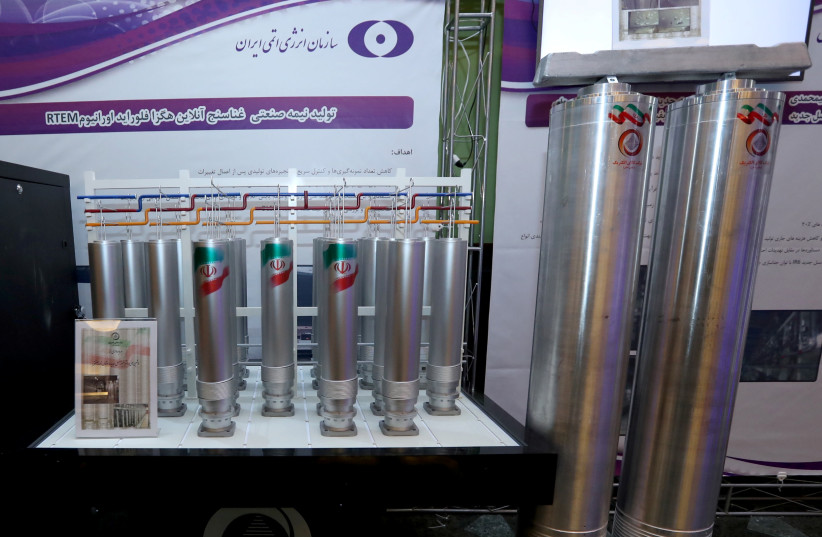IAEA likely to close some probes on Iranian nuclear sites – source
The Jerusalem Post has learned from a key source with knowledge of the Iranian nuclear negotiations that the “deal” which the Islamic Republic announced on Tuesday for closing some, but not all, of the IAEA probes into its nuclear program, is likely, but not final.
There was skepticism about Iran’s announcement from the start, being that the IAEA neither issued a public statement on the issue nor did it confirm Tehran’s statement when asked directly by the Jerusalem Post.
The IAEA has been pushing Iran since 2018-2019 to explain three undeclared nuclear sites at Turquzabad, Varamin and Marivan/Abadeh.
In addition, since late 2019, the IAEA has been pressing the ayatollahs to explain illicit nuclear material found at Turquzabad during an IAEA visit to the site as well as the location of various nuclear equipment items.
All of the above items were unveiled to the world, despite Iranian attempts to conceal them, in 2018 when the Mossad seized the Islamic Republic’s nuclear archives.
 A number of new generation Iranian centrifuges are seen on display during Iran’s National Nuclear Energy Day in Tehran, Iran April 10, 2021 (credit: IRANIAN PRESIDENCY OFFICE/WANA (WEST ASIA NEWS AGENCY)/HANDOUT VIA REUTERS)
A number of new generation Iranian centrifuges are seen on display during Iran’s National Nuclear Energy Day in Tehran, Iran April 10, 2021 (credit: IRANIAN PRESIDENCY OFFICE/WANA (WEST ASIA NEWS AGENCY)/HANDOUT VIA REUTERS)Further, in February of this year, the Islamic Republic was also caught with a small amount of molecules of uranium enriched to the 84% level at the Fordow facility.
84% enriched uranium would essentially be weaponized uranium, whereas to date the ayatollahs have said that they only enrich uranium to the mid-level point of 60%.
Iran’s claim on Tuesday was that the IAEA would close its probe into the 84% enrichment issue as well as would close their probe into the undeclared Marivan/Abadeh nuclear site.
IAEA says Iran gave ‘satisfactory answer’ about one unexplained site
An IAEA report on Wednesday said that after years of investigation and lack of progress with Iran on explaining uranium particles found at three sites, Iran had given a satisfactory answer on one of them to explain the presence of uranium particles there.
While the particles could be explained by the presence of a Soviet-operated mine and lab there and the IAEA had no further questions, a senior diplomat said, the IAEA’s assessment remained that Iran carried out explosives testing there decades ago that was relevant to nuclear weapons.
It was unclear whether this meant the IAEA would leave the probe open.
The added monitoring equipment included surveillance cameras at a site in Isfahan where centrifuge parts are made, one report said. The other added that the IAEA “awaits Iran’s engagement to address” issues including the installation of more monitoring equipment and the two remaining sites where uranium particles were found.
Tehran’s claims of the probes being closed came only days after the Islamic Republic last week said it had tested a ballistic missile with a range of 2,000 kilometers and only days before the IAEA Board of Governors is set to meet next week.
In meetings in late 2022 and earlier 2023, the IAEA Board has threatened to refer Iran’s violations to the UN Security Council for a global snapback of sanctions.
Also on Wednesday, two reports seen by Reuters said that Iran only permitted the IAEA to re-install some of the monitoring equipment originally put in place under the 2015 nuclear deal with major powers that Iran then ordered removed last year.
The re-installed equipment is a fraction of what the IAEA had planned to set up to improve its surveillance of Iran’s nuclear activities, as the IAEA said it had agreed with Iran in March in a bid to defuse a standoff between both sides over Iran’s cooperation.
The limited progress described in the reports did, however, include the installation of real-time enrichment monitoring equipment on the only lines of centrifuges enriching uranium to up to 60% purity, near weapons grade, at Natanz and Fordow, a senior diplomat said.
One IAEA report on Wednesday said Iran now had 114.1 kg of uranium enriched to up to 60% and in the form of uranium hexafluoride (UF6), which can easily be enriched further – an increase of 26.6 kg from the previous quarter.
Meanwhile, US Special Envoy on Iran, Rob Malley, told NPR in an interview, “We will use deterrence to make clear to them [Iran] that all options are on the table if we conclude that they’re taking steps that are tantamount to the decision to acquire a bomb. But we also will pursue diplomacy because we think that’s the most verifiable and sustainable way to prevent them from getting a bomb.”
When he was questioned about how soon the Islamic Republic could obtain a nuclear weapon, Malley said Tehran was a mere “couple of weeks” away from having weapons grade uranium, while noting that completing the other tasks to develop a nuclear bomb would take longer.
Also, Axios reported on Tuesday that US Middle East Envoy Brett McGurk recently visited Oman to try to explore if Iran might be open to smaller de-escalation steps regarding its nuclear program and regional confrontations. made a quiet visit to Oman in recent weeks to discuss the Iran nuclear file.
Reuters contributed to this report.





Comments are closed.